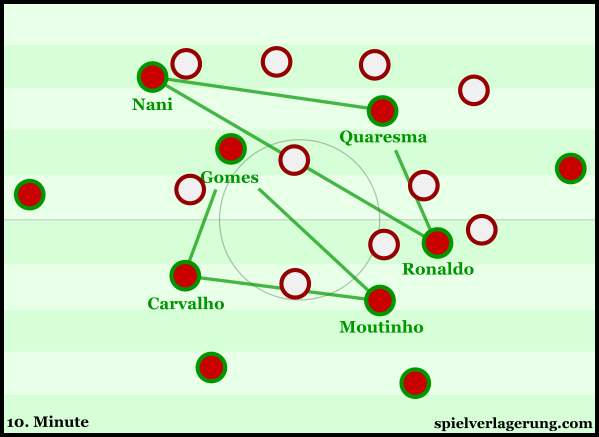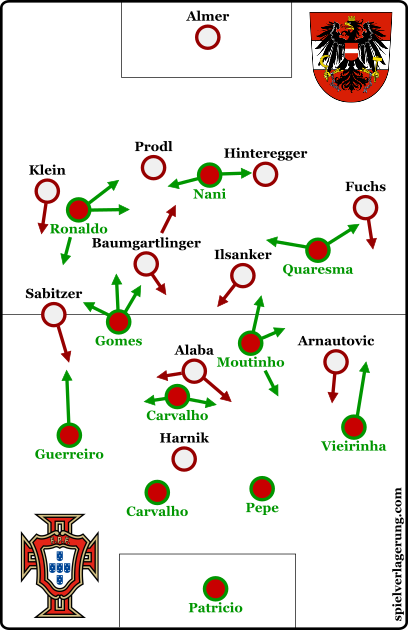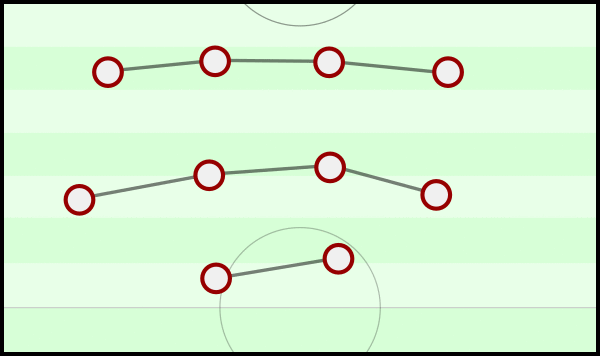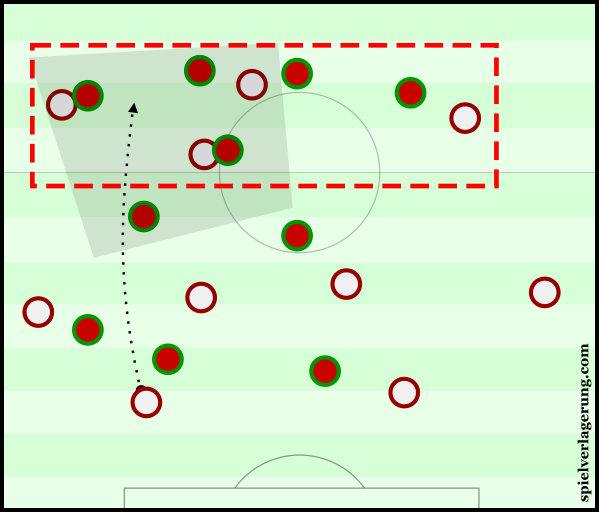Portugal’s offensive powers limited by individuality in Austria draw
Portugal made another dominant performance as they were clearly superior to their Austrian opposition. Despite having a clear shot dominance and multiple good chances, Robert Almer was in the way to prevent the Iberian side from capitalising on a strong offensive display.
A flexible 4-3-3 formation was opted for in the Portuguese dugout, with the interesting selection of Nani as the central attacker. Both full-backs were strong in advanced positions whilst Andre Gomes supported the attacks well through runs from his left 8 position in the midfield.
In opposition, Austria played in more of a broad 4-2-3-1 shape. Key player David Alaba featured in a role higher to what he is perhaps accustomed to, whilst Stefan Ilsanker and Julian Baumgartlinger formed a strong partnership in the deeper midfield.
Portugal’s Flexible Attack
In possession of the ball, Portugal adopted quite a flexible shape which took on numerous permutations throughout the duration of the game. The front six players took on a multitude of different positions throughout the game as Ronaldo in particular had a free role off of the ball.
The intentions seemed to give the attack an element of surprise and variability amongst the front three players. Through the frequent switching and rotations, all three forwards were given the opportunity to attack from different positions between each possession. By varying their approach, it’s likely that Portugal aimed to disorient the Austrian marking scheme in order to generate free players in dangerous positions; something which was somewhat effective at times.
They allowed Ronaldo in particular a free role off of the ball, though the forward’s nature and skill-set made this rarely effective. His individualistic and predatory nature is ill-suited to a role of supporting the team structurally and in ball circulation. His tendency to make purposeless tricks where simple passing would’ve been more appropriate broke down a few attacks in the first 20 minutes alone.

Quite the departure from your 4-3-3, as Ronaldo looks to impose his abilities in supporting Portugal’s build-up.
As the first half progressed, so did Portugal’s dominance as the side enjoyed large periods of possession. They clearly had the territorial advantage over their opponents and were able to generate a number of dangerous shot opportunities in the Austrian penalty area. Both Joao Moutinho and Andre Gomes began taking up more aggressive positions in the midfield whilst the full-backs supported high up their respective touchlines. Gomes in particular received the ball between Austrian lines and was able to threaten whilst the defence was more concerned by the movements of the front three.
Despite this, there was somewhat of an isolated nature surrounding Portugal’s attack. When you consider the nature of the forwards, this comes at little surprise as all three are highly individualistic attackers and not known for their team-tactical play. Combinations between the front line were few and far between and whilst they threatened individually on different occasions, their individuality was a limiting factor – especially in the latter 45. Although all three players moved actively within the midfield, situations in which they could act together were a rarity and Portugal were thus limited to individual attempts to break down Austria’s defence.
Austria’s Defensive Shape
Happy to concede the majority of possession to their Iberian opposition, Austria spent large periods of the game sat in a defensive shape which alternated between a 4-4-2 and a 4-5-1. It was the responsibility of David Alaba to provide support to his midfield and would shift back to act as an additional 8 when it was required of him. In doing so, Alaba could strengthen the midfield by adding an extra body, giving them stronger width-coverage against the movement of Portugal’s forwards. He was often required to maintain numerical balance against a Portuguese shape which featured both Ronaldo and Quaresma coming inside regularly.
His deeper positioning also acted to support the defensive work of Baumgartlinger and Ilsanker who, particularly the former, were active in moving out to apply pressure on the Portuguese midfield. The rather dynamic shape resulted in an adaptable defensive block, allowing Austria to cover the shifting Portugal attack and maintain a fairly decent level of access.
Within the more standard 4-4-2 shape Austria defended fairly competently with the midfield making their horizontal shifts well in a zonal block. The opposition positioning was alternatively a common reference point for the positioning of both Baumgartlinger and Ilsanker, who both often had to move slightly wider than normal to establish access to their man. Despite this requirement (as the Portuguese 8s could be slightly wider than that of an orthodox 8), they maintained their stability fairly well, even if it came at the expense of some horizontal compactness across the midfield 4.
Portugal Stifle Austria’s Build-Up
One of the common themes during the first half was Austria’s inability to pass the ball out from areas deep within their own half. Whilst Almer looked competent when saving the shots of Portugal’s forwards, he failed to show a similar ability in distributing the ball from his penalty area. With Austria clearly struggling to build the possession effectively, Portugal were inclined to adopt an aggressive position into Austria’s third and did so to good effect. The forwards took somewhat of a loose man-to-man approach in order to restrict the passing options whilst maintaining a high position for any resulting turnovers.
Against Portugal’s high position, Austria were rarely able to establish sustained, developed periods of possession. They had clear difficulty in passing the ball through the lines of players and instead were contained to more direct and vertical build-ups. This was effective in progressing the ball in a few instances through the left half-space but they were unable to consistently break through the Portuguese press. Austria found difficulty in effectively integrating key attackers such as Alaba and Sabitzer who were regularly isolated whilst their teammates built possession deeper.
Although Portugal did their job well, they rarely had to exert themselves within Austria’s third. The majority of problems were conceived by Austria by themselves as their system made effective ball circulation a difficult task for what is an individually-talented side.
The front four were often far too stretched across the width of the pitch with Arnautovic and Sabitzer both taking wide positions in most scenes. Whilst Austria were able to make a couple of breakthroughs down the sides with both Alaba and Harnik shifting over to combine with the ball-near winger, the stretched nature made it difficult to engage the attack together. The ball-far winger was rarely able to truly impact the Austrian attacks whilst combinations past the initial breakthrough were uncommon.
The often-unnecessary width of the attack meant that Austria were often underloaded against Portugal’s defence when contesting long balls. With numerical inferiority against their opponents, they were unable to maintain possession of the ball after direct play and as a result could not make well-developed attacks.
Austria’s movement across the attack also lacked a clear level of dynamism. Particularly in the wide forwards, their roles were rather static as they didn’t often foray further from their respective wing-spaces. Alaba showed some intentions to find possession with small movements into any open gaps but was still far too isolated to have a telling impact on the game in what was an underwhelming performance.
Another self-inflicted issue was the pace of ball circulation in the deeper areas during build-up. The ball was often moved at a lethargic pace between the Austrian first and second lines which served to simply invite Portugal to take a higher position in their press. This resulted in many attempts at building-up ending in a return pass to Almer and then a consequential long ball. The absence of momentum in the ball circulation made it a bigger challenge to break through the lines of pressure with the large majority of the passes being sideways. Austria’s inability to effectively construct possession caused a great deal of turnovers in the first half alone.
Second Half Developments
In contrast to the first 45, the game became more even after the teams re-emerged following the half-time break.
Frustrated by their lack of a breakthrough, Portugal began taking on more attacking positions, with Andre Gomes in particular acting closer to a 10 than his original position deeper within the midfield triangle. The battle for possession was a continuation of the first half, with the Iberian team enjoying more of the ball and consequently better territory too. Despite their efforts though, they were unable to create the same quality chances they had in the first half despite the late penalty miss and disallowed goal.
Their individuality remained an issue, with isolated wing attacks becoming a common theme whilst the other forwards waited in expectation from within the penalty area. The lack of offensive teamwork was on of the biggest limiting factors on Portugal’s performance on the attack, with the chance of combining with teammates rarely possible. Whilst the build-up to the final third was strong, with players such as Joao Moutinho, Raphael Guerreiro and especially Andre Gomes impressing, their final third play was rather linear. Because of this, the possibilities in attack were immediately restricted often to ineffective crosses from deep positions.
Austria improved, too. Although they were still on the back foot for large periods, they were now able to joy more controlled bouts of possession in Portugal’s half. The long balls which had rarely been successful in the first half were now being completed more often whilst more importantly, they were able to better retain possession on the second ball. This served as a much-needed means of progressing the possession past Portugal’s press where previously Austria had no little way of consistently keeping the ball outside their own half.
Conclusion
Whilst Portugal put in an impressive performance with a clear dominance for the second game in a row, they were left disappointed with another draw. Promising signs were a plenty in the performances of players such as Andre Gomes and Raphael Guerreiro yet despite the 23-4 shot dominance, there seems to a restricting factor on their attack. The forwards made few attempts to form attacks as a collective and when a team fails to properly work together in the final third, only so much can be achieved.
Despite having such an individually-talented squad, Austria disappointed in a game which teased to be one of the more interesting clashes in recent days. Systemic issues were central to the poor team performance as players such as David Alaba were unable to truly impact the game, though the performances of such individuals must also be questioned.





3 Kommentare Alle anzeigen
Matt June 23, 2016 um 5:44 pm
I didn’t get to see much of the game but weren’t Austria in a 4-4-2 formation? To me if one of the forwards doesn’t drop deep to help with the buildup in the center doesn’t that effect them keeping possession in which makes the team either more direct and or wing oriented? Please let me know what you guys think?
Dalot June 19, 2016 um 2:47 pm
Nani as the central attacker ? No, he wasn’t… ?
TP June 19, 2016 um 3:54 pm
Yes, he was. None were fixed positions but Nani mainly acted in the central position.